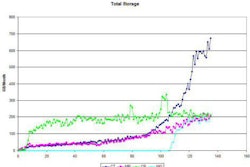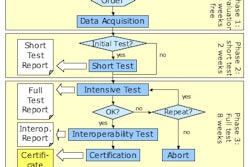As a practicing pediatrician, Dr. Cedric Priebe III knows the value of having accurate and current medical information on his patients.
To appropriately care for newborns at Women & Infants Hospital in Providence, RI, Priebe needs to know, among other things, the mother's prenatal screening laboratory results. "If that woman had a Women & Infants lab test, we're golden. I can look it up in our system and see everything," he said.
Of course, not every mother-to-be has her prenatal lab tests performed at Women & Infants or one of Care New England's other Rhode Island facilities. "Getting those prenatal lab results (from elsewhere) are often problematic.... Sometimes when they come on paper, they are illegible," Priebe said.
To eliminate those kinds of impediments and optimize healthcare, Rhode Island is creating a statewide health information exchange (HIE) to make some patient data more readily available to hospitals and other providers.
"Under this type of model, if the woman's prenatal labs were done elsewhere and we could look into the system and see that information -- based on authorization from the mother -- that would have immediate value," said Priebe, who also serves as Care New England's chief information officer.
HIE's inception
Rhode Island's data-sharing initiative began when the state Department of Health (DOH), at the request of the Rhode Island Quality Institute (RIQI), applied for and received $5 million from the U.S. Agency for Healthcare Research and Quality to create the exchange.
In late July, the DOH awarded a three-year, $1.7 million contract to Electronic Data Systems (EDS) to build and integrate a network to provide authorized hospitals, doctors, pharmacists, and other healthcare providers with more complete patient health records. The contract contains an option for four additional years to continue development of the HIE. The Plano, TX-based software technology firm also serves as Rhode Island's Medicaid fiscal agent.
"It is a matter of integrating a number of disparate systems into a health information exchange that can provide data to healthcare providers in the state," said Tom O'Brien, managing director of EDS' Electronic Health Records Center of Excellence. He is stationed in Rhode Island, working with local officials and healthcare providers on the HIE. "We will be working with a subcontractor, InterSystems (Cambridge, MA), which will provide some of the software for the exchange."
One of the contract requirements is that the HIE does not place a significant burden -- financially or technologically -- on the participating data-sharing partners. "We had to develop an approach that would allow the data-sharing partners to provide access to their data in a way that would not require them to make changes at their end and provide the ability for us to see into their systems," O'Brien said.
The exchange participants will make the appropriate data available in an interim form, which EDS can access, but the company will not be allowed to access providers' patient data information systems directly.
The state also designated RIQI as the governing body for the project. "For example, the institute receives a small amount of money for the governance" of the HIE, explained RIQI president and CEO Laura Adams. "We have just begun to give some money to EDS to begin the technical build. The money comes in increments as the work is completed."
One step at a time
The HIE database will be built in stages, starting with patients' lab results and medication history. "We envision other information going in and continuing to expand to other data, like chart summary reports, radiology, vital signs, allergies, immunizations, but not necessarily in that order," said Amy Zimmerman, chief of the Rhode Island Information Exchange Project. "I don't know that we envision it being a complete medical record with all (doctors') notes, but it will have basic core information."
The first healthcare facilities to connect to the exchange will be the hospitals of Lifespan, the East Side Clinical Laboratory, and the state DOH health laboratory, all based in Providence. Lifespan includes Rhode Island Hospital, Hasbro Children's Hospital, Miriam Hospital, Newport Hospital, and Bradley Hospital in East Providence. Lifespan also has been an active HIE supporter, offering, among other things, technical expertise of its IT staff.
Information on medication histories will come from SureScript of Alexandria, VA. The e-prescription firm has created a medication history database through national pharmacy chains, such as CVS/pharmacy and RiteAid, which SureScript serves.
"Our goal over the next 12 to 18 months is to get the initial phase operational and piloting it at five healthcare provider settings to be determined," Zimmerman said. Three years from now, organizers hope to have the additional data-sharing partners online, as well as other users.
All of the data-sharing partners have agreed to use standard message technology. Lab results, for example, will be sent in HL7 version 2.5. "The result that is contained in that message -- like blood sugar information -- will have our label on it and EDS will take everybody's blood sugar, assign them the same code number, and put them in the same place," noted Dr. Reid Coleman, medical informatics officer at Lifespan and member of the HIE standards committee.
HIE compatibility
Coleman doesn't expect Lifespan to make any significant technical modifications to connect to the HIE. Lifespan currently has a clinical information system that connects Rhode Island, Miriam, and Newport Hospitals. A healthcare provider at Lifespan can access information about a patient at any of the three hospitals, though the viewer may not necessarily know from which facility the data comes.
The IT system, which includes a PACS, contains data such as lab results, x-ray images and reports, echocardiograms, and cardiac and stress test results. "It also has a complete list of all medications given to any one of our patients while ... in the hospital," Coleman said. "It has an electronic CPOE (computerized physician order entry system) and over 90% of our medication orders are entered into the computer by doctors."
That information goes directly to Lifespan's pharmacy electronically. A pharmacist approves the order electronically, and the order goes to a medication administration checking system electronically. A nurse also will check the bar codes to ensure that the medication is dispensed correctly.
"Any physician who works at a Lifespan hospital has to know how to use our computer system to find our clinical data, to look at x-rays, and to write orders," Coleman added. "They have to be familiar with every part of the system if they are going to take care of patients in Lifespan hospitals."
The only anticipated adjustments for the HIE will be in the way Lifespan sends data for patients who have given consent to have their information stored on the network. "We have to add programming to check for that consent before the information is sent," he said. "That's the only real adjustment we have to make."
Still, Coleman anticipates the possibility of compatibility problems. Even though national standards are emerging, they are not uniformly adopted nor are they uniformly implemented among healthcare facilities. "The plan for the central repository -- which is not yet complete -- involves EDS taking input from the various partners, as long as we provide (EDS) a standard format and normalize the data -- which means taking it as it comes in and mapping it to standardized codes for storage."
HL7 interfaces
Care New England also has been actively involved in the developing the HIE. The healthcare system, which includes Kent County Hospital in Warwick and Butler Hospital in Providence, anticipates connecting to the network in 2009. Until then, Care New England has time to get its technology in order (on July 27, Care New England and Lifespan announced plans to merge into one entity under the Lifespan banner).
"Even through we call it standard HL7, if you have seen one interface, you've seen one interface. Each one will need attention," Priebe said. "If we are adding a layer of enrollment and authorization for HIE, we need to understand how that affects our patient access processes and our workflow."
Care New England has a clinical IT system, which is utilized at its three facilities, along with RIS and PACS capabilities. "We are in fairly good position to provide an outbound feed to the HIE," Priebe said, "though I don't want to minimize the complexity of doing that in a way that respects the patient's authorization and security."
With the help of EDS technology, Priebe describes "a fairly complex messaging sequence" between data-sharing partners and the HIE. The hospitals first will query the HIE to confirm patient authorization before any data is submitted from the partner to the network as a check to ensure no information is released without authorization.
HIPAA challenges
One of the biggest challenges facing the HIE is safeguarding patient information as stipulated in the Health Insurance Portability and Accountability Act (HIPAA) of 1996.
A major role of the RIQI is to build awareness in the state about the exchange and establish guidelines for the authorization and dissemination of patient information. To that end, over the last 18 months the organization has assembled HIPAA privacy law experts, the American Civil Liberties Union, advocacy groups for domestic violence, mental health organizations, third-party payers, healthcare providers, and other community leaders with a vested interest in the HIE.
"We have been working hard to get a cross-section of the entire community," Adams said. "We can't build a system that people don't feel confident about."
Organizers have agreed to a policy whereby patients voluntarily would "opt in" to the HIE, rather than be automatically included in the database and must ask to have their information removed from it. The specific process for patient authorization has not yet been determined.
HIPAA privacy and security statutes have served as the guide in much of the community leaders' discussions in creating HIE policies. While HIPAA provides coverage in many areas, there are a few concerns about where its guidelines may fall short. Adams said the RIQI's committee will make some HIPAA components more stringent.
Ethical issues
"When you start collecting information from all the different organizations, the risk starts to go up and people want much more active consent to have that kind of sharing done," Adams said. "That's where HIPAA allows a lot of latitude; people were somewhat concerned and want more protection."
Lifespan's Coleman said it is "fair to say that the design of the statewide system exceeds HIPAA. We are supremely confident that this system is both private and secure. Because we require the patient's consent before we put any information in the repository, that (policy) goes beyond HIPAA."
Adams said one other issue among community leaders is whether entities should be able to query the HIE database, for example, to gather information on all diabetics in Rhode Island. "There are some very honorable and ethical uses of the data for research," she added, "but people are questioning whether there are other ways that data may be used."
For instance, could researchers for a clinical trial access the data? While proponents of such studies would advocate that the patient data be used to improve healthcare, opponents would assert potential conflicts in a scenario whereby a pharmaceutical company would offer, say, $1 million to the regional health information organization (RHIO) for access to HIE data. "Those are some of the possibilities, but not without strong community policy oversight," Adams said.
RIQI could become the organization that oversees and maintains the viability of the HIE when completed. It was the only entity to submit an application to the state by the August 31 deadline to become the HIE's RHIO.
The RHIO would be responsible for expanding the HIE beyond the current list of data-sharing partners, as well as finding the funds to support the exchange's expansion and handling policy issues.
RIQI still must meet 75% of the state's criteria to be confirmed as the RHIO. "We need to be recognized legitimately in the public's eye," Adams said.
HIE timeline
How long it will take to complete the statewide HIE is only an estimate right now. Adams believes the initiative could "extend well beyond five to seven years before we have every single organization wired in the state."
Because much of Rhode Island's healthcare is delivered by small physician practices -- some with only one or two doctors -- Adams said some people refer to that segment of the provider population "as the last mile" to HIE's finish line.
Lifespan's Coleman said his "best guess" from data he has seen is that approximately 12% of Rhode Island physician offices have electronic medical record technology, but he added that estimate is from "very shaky information."
"I think it is fair to say that the reason that more doctors are not using electronic medical records is not because they don't know how to use the technology. It has more to do with cost and a lot of the ambulatory technology is not interoperable yet," he said.
While no HIE is a one-size-fits-all IT system, EDS' O'Brien said other locales around the U.S. are watching the approach Rhode Island is taking with its initiative. "This is something that is precedent-setting and is being watched by many states," he added.
Rhode Island officials also expect to draw the attention of other state, county, and regional officials, as well as other RHIOs, to monitor the state's progresses and learn from Rhode Island's experience. "There is a sense that what we can do here can be scaled up and replicated in other places," Adams said. "If we can't do it, who can?"
By Wayne Forrest
AuntMinnie.com staff writer
September 21, 2007
Related Reading
Florida, DoD to develop HIT exchange, April 6, 2007
3M tapped by Maine HIE, March 27, 2007
U.S. takes steps to ramp up HIT efforts, February 23, 2007
Washington advocates healthcare information banks, December 6, 2006
Delaware awards Medicity statewide HIE contract, October 6, 2006
Copyright © 2007 AuntMinnie.com



















